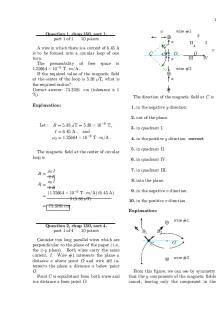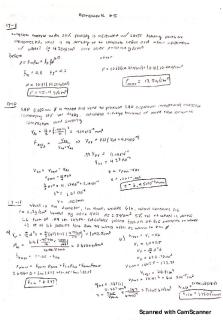Homework 5 - Basic Regression PDF

| Title | Homework 5 - Basic Regression |
|---|---|
| Author | Anonymous User |
| Course | Intro to Analytics Modeling |
| Institution | Georgia Institute of Technology |
| Pages | 8 |
| File Size | 238.2 KB |
| File Type | |
| Total Downloads | 41 |
| Total Views | 151 |
Summary
Basic Regression...
Description
Question 8.1 Describe a situation or problem from your job, everyday life, current events, etc., for which a linear regression model would be appropriate. List some (up to 5) predictors that you might use. Solution: I have a little company that sells pipe hookah tobacco and we can use a linear regression model to understand the correlation between the amount of money we spend for advertising and revenue. We can fit a simple linear regression model with one predictor variable – Ads spending and the revenue as the response variable. We are using the ads spending as predictor because that is the effect we want to study; but in general, revenue can have many other predictors such as price, number of competitors, unemployment rate.
Question 8.2 Using crime data from http://www.statsci.org/data/general/uscrime.txt (file uscrime.txt, description at http://www.statsci.org/data/general/uscrime.html ), use regression (a useful R function is lm or glm) to predict the observed crime rate in a city with the following data: M = 14.0 So = 0 Ed = 10.0 Po1 = 12.0 Po2 = 15.5 LF = 0.640 M.F = 94.0 Pop = 150 NW = 1.1 U1 = 0.120 U2 = 3.6 Wealth = 3200 Ineq = 20.1 Prob = 0.04 Time = 39.0
Show your model (factors used and their coefficients), the software output, and the quality of fit.
Note that because there are only 47 data points and 15 predictors, you’ll probably notice some overfitting. We’ll see ways of dealing with this sort of problem later in the course.
Solution: To approach this problem, we first fitted a regression model (Model1) using all the 47 data points. Since we have a small data set, we decided not to split the data into train-test. After we fitted and analyzed “Model1” output, we noted that predictors like “Mean years of schooling of the population aged 25 years or over”(Ed) and “Income inequality: percentage of families earning below half the median income”(Ineq) have less impact on the model since their coefficients are below or equal to 0.001. So, we decided to create another model (Model2) without “Ed” and “Ineq” predictors to see if we get a better-quality model. However, after computing and comparing the sum of squared error for both models, we found that “Model1” has the least sum of squared error - Model1 sum of squared error= 1354946, Model2 sum of squared error= 2038089. Also looking at the Adjusted R-squared values, we see that “Model1” has greater R-squared (which mean that Model1 accounted more for the variability in the data). So, in sum, we ended up working with “Model1” to predict the test city crime based on data provided above and we got a crime rate of 155 per 100000 population. Below is the output details of Model1:
lm(formula = Crime ~ ., data = uscrimeData) Residuals: Min 1Q -395.74 -98.09
Median -6.69
3Q 112.99
Max 512.67
Coefficients: (Intercept) M So Ed Po1 Po2 LF M.F Pop NW U1 U2 Wealth Ineq Prob Time
Estimate Std. Error t value Pr(>|t|) -5.984e+03 1.628e+03 -3.675 0.000893 *** 8.783e+01 4.171e+01 2.106 0.043443 * -3.803e+00 1.488e+02 -0.026 0.979765 1.883e+02 6.209e+01 3.033 0.004861 ** 1.928e+02 1.061e+02 1.817 0.078892 . -1.094e+02 1.175e+02 -0.931 0.358830 -6.638e+02 1.470e+03 -0.452 0.654654 1.741e+01 2.035e+01 0.855 0.398995 -7.330e-01 1.290e+00 -0.568 0.573845 4.204e+00 6.481e+00 0.649 0.521279 -5.827e+03 4.210e+03 -1.384 0.176238 1.678e+02 8.234e+01 2.038 0.050161 . 9.617e-02 1.037e-01 0.928 0.360754 7.067e+01 2.272e+01 3.111 0.003983 ** -4.855e+03 2.272e+03 -2.137 0.040627 * -3.479e+00 7.165e+00 -0.486 0.630708
--Signif. codes:
0 ‘***’ 0.001 ‘**’ 0.01 ‘*’ 0.05 ‘.’ 0.1 ‘ ’ 1
Residual standard error: 209.1 on 31 degrees of freedom Multiple R-squared: 0.8031, Adjusted R-squared: 0.7078 F-statistic: 8.429 on 15 and 31 DF, p-value: 3.539e-07
(See below for full analysis of question 8.2 in R) #read data uscrimeData...
Similar Free PDFs

Homework 5 - Basic Regression
- 8 Pages

Chapter 5 regression
- 7 Pages

Homework 5
- 2 Pages

Homework 5
- 9 Pages

Homework 5
- 4 Pages

Hoework 5 - homework 5
- 3 Pages

Homework 5
- 2 Pages

HW 5 - Week 5 homework
- 6 Pages

Regression MCQuestions
- 8 Pages

Regression MCQuestions
- 8 Pages

Regression analysis
- 3 Pages

Chapter 5 HW - Homework
- 2 Pages
Popular Institutions
- Tinajero National High School - Annex
- Politeknik Caltex Riau
- Yokohama City University
- SGT University
- University of Al-Qadisiyah
- Divine Word College of Vigan
- Techniek College Rotterdam
- Universidade de Santiago
- Universiti Teknologi MARA Cawangan Johor Kampus Pasir Gudang
- Poltekkes Kemenkes Yogyakarta
- Baguio City National High School
- Colegio san marcos
- preparatoria uno
- Centro de Bachillerato Tecnológico Industrial y de Servicios No. 107
- Dalian Maritime University
- Quang Trung Secondary School
- Colegio Tecnológico en Informática
- Corporación Regional de Educación Superior
- Grupo CEDVA
- Dar Al Uloom University
- Centro de Estudios Preuniversitarios de la Universidad Nacional de Ingeniería
- 上智大学
- Aakash International School, Nuna Majara
- San Felipe Neri Catholic School
- Kang Chiao International School - New Taipei City
- Misamis Occidental National High School
- Institución Educativa Escuela Normal Juan Ladrilleros
- Kolehiyo ng Pantukan
- Batanes State College
- Instituto Continental
- Sekolah Menengah Kejuruan Kesehatan Kaltara (Tarakan)
- Colegio de La Inmaculada Concepcion - Cebu



